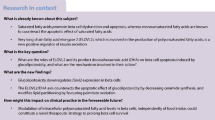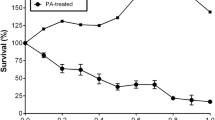Abstract
Chronic exposure to elevated levels of fatty acids (FAs) in conjunction with chronic hyperglycemia has been reported to contribute to the progressive deterioration of β-cell function in patients with type 2 diabetes mellitus. The long-chain saturated free fatty acid (FFA) palmitate, unlike the unsaturated FFA oleate, is known to have an inhibitory effect on proinsulin gene expression through ceramide synthesis. This study was aimed at investigating whether this effect was exacerbated by the inhibition of ceramide degradation in pancreatic β-cells and the molecular mechanism of intracellular ceramide-induced inhibition of proinsulin gene transcription in response to exposure to palmitate. We exposed insulin-secreting (INS-1) cells treated with low levels of palmitate to the ceramidase inhibitor n-oleoylethanolamine (NOE); this led to the generation of high levels of intracellular ceramide. We observed that the effects of ceramide accumulation in INS-1 cells were similar to the effects of the inhibition of this protein on proinsulin mRNA levels that are caused by the negative regulation of insulin promoter activity. In addition, we observed that ceramide accumulation induced by NOE leads to a significant decrease in the levels of activated extracellular signal-regulated kinase (ERK); the inactivation of the ERK cascade in response to palmitate stimuli is induced by protein phosphatase 2A (PP2A) activity. Based on these findings, we suggest that the aberrant accumulation of ceramide was caused by the inhibition of ceramide metabolism, which in turn leads to the inhibition of proinsulin gene expression; the inhibition of ERK cascades by PP2A serves as an important factor in the inhibitory effects of ceramide.





Similar content being viewed by others
References
Brookheart RT, Michel CI, Schaffer JE (2009) As a matter of fat. Cell Metab 10:9–12
Karaca M, Magnan C, Kargar C (2009) Functional pancreatic beta-cell mass: involvement in type 2 diabetes and therapeutic intervention. Diabetes Metab 35:77–84
Garbarino J, Sturley SL (2009) Saturated with fat: new perspectives on lipotoxicity. Curr Opin Clin Nutr Metab Care 12:110–116
Oprescu AI, Bikopoulos G, Naassan A, Allister EM, Tang C, Park E, Uchino H, Lewis GF, Fantus IG, Rozakis-Adcock M, Wheeler MB, Giacca A (2007) Free fatty acid-induced reduction in glucose-stimulated insulin secretion: evidence for a role of oxidative stress in vitro and in vivo. Diabetes 56:2927–2937
Moore PC, Ugas MA, Hagman DK, Parazzoli SD, Poitout V (2004) Evidence against the involvement of oxidative stress in fatty acid inhibition of insulin secretion. Diabetes 53:2610–2616
Mathias S, Peña LA, Kolesnick RN (1998) Signal transduction of stress via ceramide. Biochem J 335:465–480
Merrill AH Jr (2002) De novo sphingolipid biosynthesis: a necessary, but dangerous, pathway. J Biol Chem 277:25843–25846
Chavez JA, Holland WL, Bär J, Sandhoff K, Summers SA (2005) Acid ceramidase overexpression prevents the inhibitory effects of saturated fatty acids on insulin signaling. J Biol Chem 280:20148–20153
Straczkowski M, Kowalska I, Baranowski M, Nikolajuk A, Otziomek E, Zabielski P, Adamska A, Blachnio A, Gorski J, Gorska M (2007) Increased skeletal muscle ceramide level in men at risk of developing type 2 diabetes. Diabetologia 50:2366–2373
Larsen L, Størling J, Darville M, Eizirik DL, Bonny C, Billestrup N, Mandrup-Poulsen T (2005) Extracellular signal-regulated kinase is essential for interleukin-1-induced and nuclear factor kappaB-mediated gene expression in insulin-producing INS-1E cells. Diabetologia 48:2582–2590
Coll T, Jové M, Rodríguez-Calvo R, Eyre E, Palomer X, Sánchez RM, Merlos M, Laguna JC, Vázquez-Carrera M (2006) Palmitate-mediated downregulation of peroxisome proliferator-activated receptor-gamma coactivator 1alpha in skeletal muscle cells involves MEK1/2 and nuclear factor-kappaB activation. Diabetes 55:2779–2787
Khoo S, Griffen SC, Xia Y, Baer RJ, German MS, Cobb MH (2003) Regulation of insulin gene transcription by ERK1 and ERK2 in pancreatic β cells. J Biol Chem 278:32969–32977
Hagman DK, Hays LB, Parazzoli SD, Poitout V (2005) Palmitate inhibits insulin gene expression by altering PDX-1 nuclear localization and reducing MafA expression in isolated rat islets of Langerhans. J Biol Chem 280:32413–32418
Lawrence MC, McGlynn K, Shao C, Duan L, Naziruddin B, Levy MF, Cobb MH (2008) Chromatin-bound mitogen-activated protein kinases transmit dynamic signals in transcription complexes in beta-cells. Proc Natl Acad Sci USA 105:13315–13320
Stratford S, Hoehn KL, Liu F, Summers SA (2004) Regulation of insulin action by ceramide: dual mechanisms linking ceramide accumulation to the inhibition of Akt/protein kinase B. J Biol Chem 279:36608–36615
Zhao J, Wu HW, Chen YJ, Tian HP, Li LX, Han X, Guo J (2008) Protein phosphatase 2A-negative regulation of the protective signaling pathway of Ca2+/CaM-dependent ERK activation in cerebral ischemia. J Neurosci Res 86:2733–2745
Hatada K, Washizuka T, Horie M, Watanabe H, Yamashita F, Chinushi M, Aizawa Y (2006) Tumor necrosis factor-alpha inhibits the cardiac delayed rectifier K current via the asphingomyelin pathway. Biochem Biophys Res Commun 344:189–193
Dubois M, Kerr-Conte J, Gmyr V, Bouckenooghe T, Muharram G, D’Herbomez M, Martin-Ponthieu A, Vantyghem MC, Vandewalle B, Pattou F (2004) Non-esterified fatty acids are deleterious for human pancreatic islet function at physiological glucose concentration. Diabetologia 47:463–469
Sol ER, Hovsepyan M, Bergsten P (2009) Proteins altered by elevated levels of palmitate or glucose implicated in impaired glucose-stimulated insulin secretion. Proteome Sci 7:24
Assimacopoulos-Jeannet F (2004) Fat storage in pancreas and in insulin-sensitive tissues in pathogenesis of type 2 diabetes. Int J Obes Relat Metab Disord 28:S53–S57
Kelpe CL, Moore PC, Parazzoli SD, Wicksteed B, Rhodes CJ, Poitout V (2003) Palmitate inhibition of insulin gene expression is mediated at the transcriptional level via ceramide synthesis. J Biol Chem 278:30015–30021
Shimabukuro M, Zhou Y-T, Levi M, Unger RH (1998) Fatty-acid induced β-cell apoptosis: a link between obesity and diabetes. Proc Natl Acad Sci USA 95:2498–2502
Shimabukuro M, Higa M, Zhou YT, Wang MY, Newgard CB, Unger RH (1998) Lipoapoptosis in β-cells of obese prediabetic fa/fa rats. Role of serine palmitoyltransferase overexpression. J Biol Chem 273:32487–32490
Poitout V, Hagman D, Stein R, Artner I, Robertson RP, Harmon JS (2006) Regulation of the insulin gene by glucose and fatty acids. J Nutr 136:873–876
Lawrence MC, McGlynn K, Park BH, Cobb MH (2005) ERK1/2-dependent activation of transcription factors required for acute and chronic effects of glucose on the insulin gene promoter. J Biol Chem 280:26751–26759
Kaneto H, Matsuoka TA, Kawashima S, Yamamoto K, Kato K, Miyatsuka T, Katakami N, Matsuhisa M (2009) Role of MafA in pancreatic beta-cells. Adv Drug Deliv Rev 61:489–496
Rodriguez-Viciana P, Collins C, Fried M (2006) Polyoma and SV40 proteins differentially regulate PP2A to activate distinct cellular signaling pathways involved in growth control. Proc Natl Acad Sci USA 103:19290–19295
Junttila MR, Li SP, Westermarck J (2008) Phosphatase-mediated crosstalk between MAPK signaling pathways in the regulation of cell survival. FASEB J 22:954–965
Acknowledgment
This study was supported by grants from the National Natural Science Foundation of China (No. 30871200).
Author information
Authors and Affiliations
Corresponding author
Rights and permissions
About this article
Cite this article
Guo, J., Qian, Y., Xi, X. et al. Blockage of ceramide metabolism exacerbates palmitate inhibition of pro-insulin gene expression in pancreatic β-cells. Mol Cell Biochem 338, 283–290 (2010). https://doi.org/10.1007/s11010-009-0362-4
Received:
Accepted:
Published:
Issue Date:
DOI: https://doi.org/10.1007/s11010-009-0362-4




